University Accounting Assignment: Financial Reporting and Analysis
VerifiedAdded on 2021/04/17
|18
|2488
|43
Homework Assignment
AI Summary
This accounting assignment solution covers a range of topics, including plagiarism, spreadsheet views (normal and formula), website resources for accounting, and the Association of Accounting Technicians (AAT). It explores the impact of technology in accounting, using computers for data saving, protection, emails, and accessibility while also noting the risks of hacking and lack of internal control. The assignment analyzes the ABC Learning case, highlighting financial reporting, ethical issues, and the importance of sound accounting principles. It further discusses PALER segregation, owner's drawings calculation, normal debit and credit balance accounts, and adjusting entries (accrued revenue, expenses, deferred revenue, and expenses). Additionally, it defines current and non-current liabilities with examples. The document provides detailed answers and explanations for each question, offering a comprehensive overview of fundamental accounting concepts and their practical application.
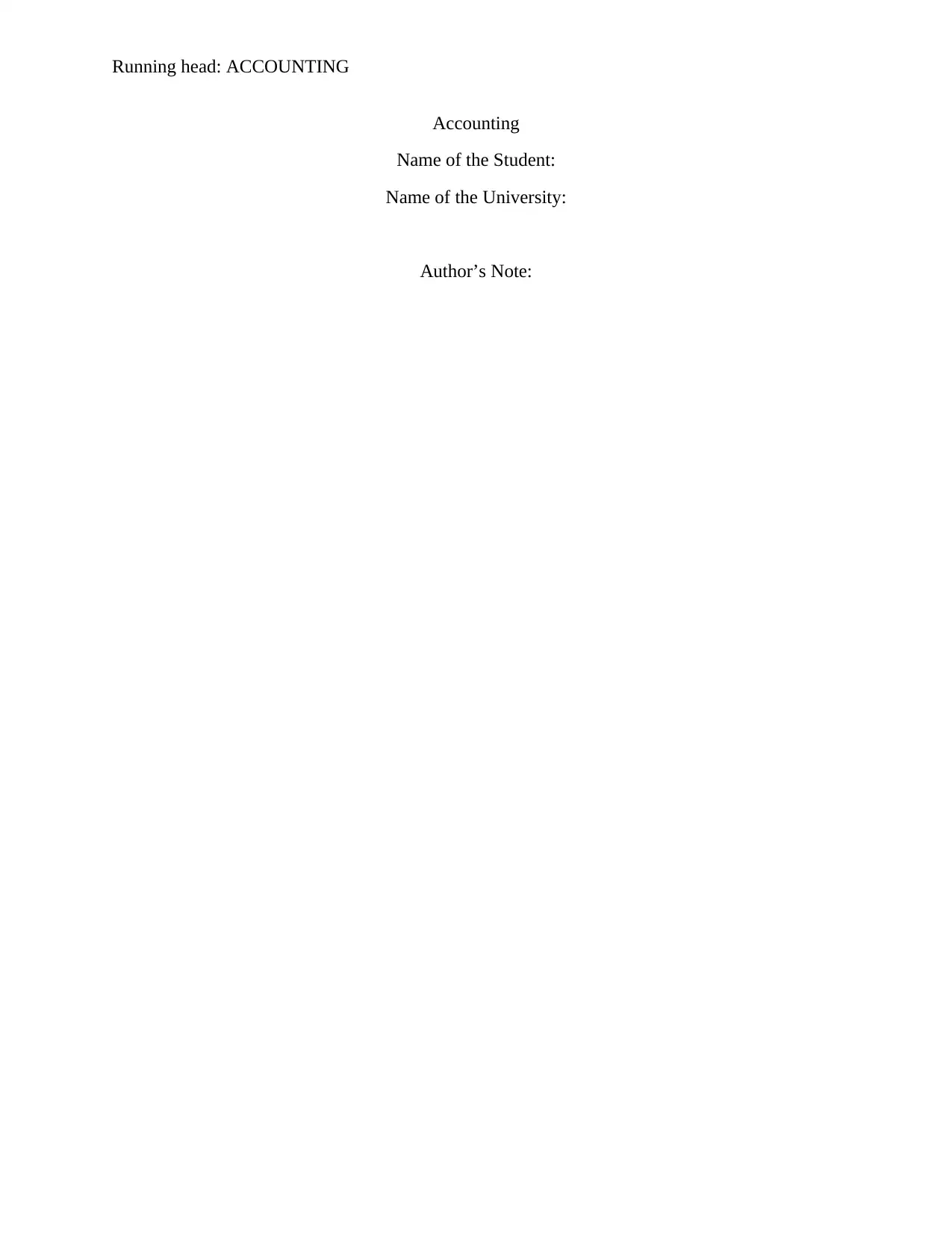
Running head: ACCOUNTING
Accounting
Name of the Student:
Name of the University:
Author’s Note:
Accounting
Name of the Student:
Name of the University:
Author’s Note:
Paraphrase This Document
Need a fresh take? Get an instant paraphrase of this document with our AI Paraphraser
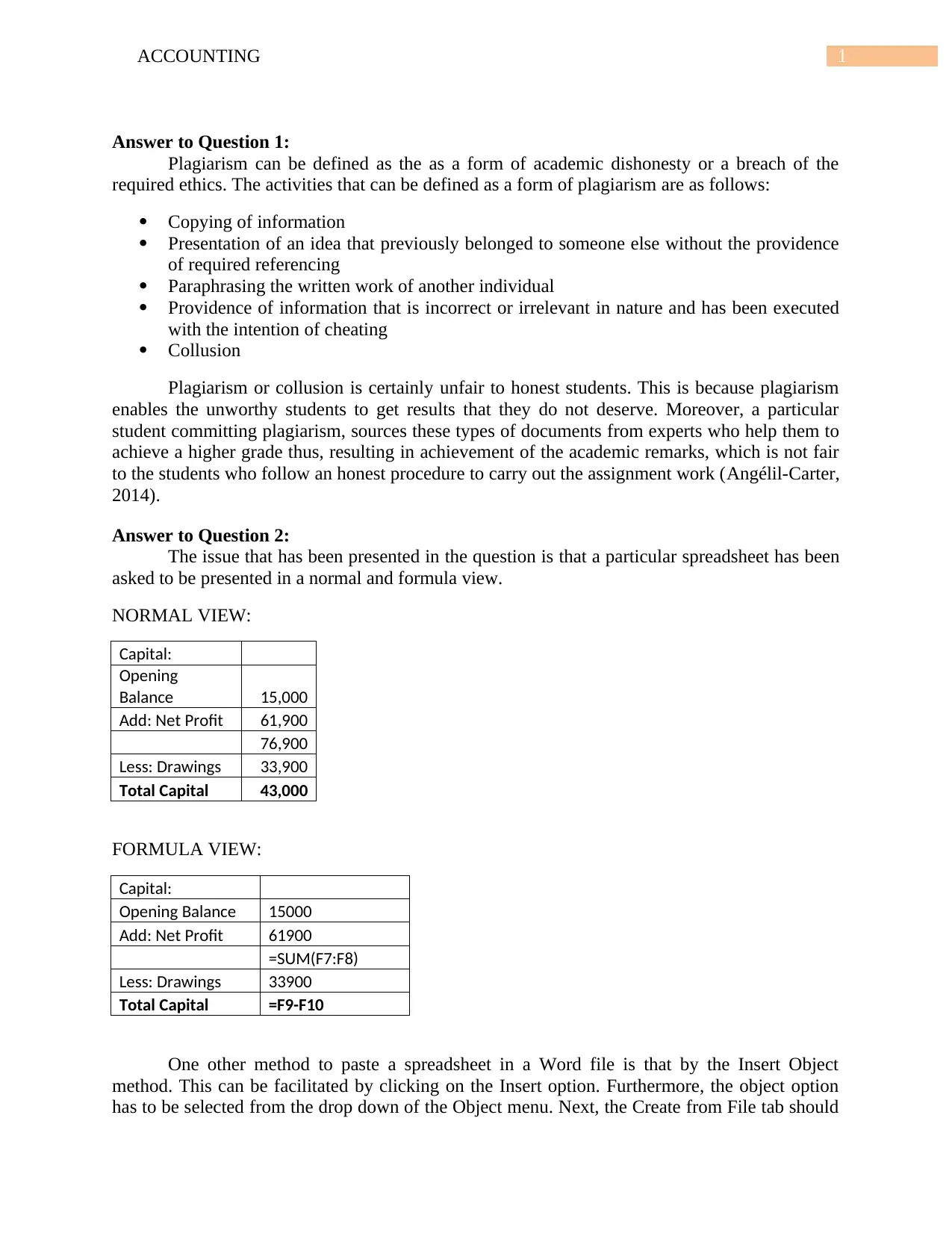
1ACCOUNTING
Answer to Question 1:
Plagiarism can be defined as the as a form of academic dishonesty or a breach of the
required ethics. The activities that can be defined as a form of plagiarism are as follows:
Copying of information
Presentation of an idea that previously belonged to someone else without the providence
of required referencing
Paraphrasing the written work of another individual
Providence of information that is incorrect or irrelevant in nature and has been executed
with the intention of cheating
Collusion
Plagiarism or collusion is certainly unfair to honest students. This is because plagiarism
enables the unworthy students to get results that they do not deserve. Moreover, a particular
student committing plagiarism, sources these types of documents from experts who help them to
achieve a higher grade thus, resulting in achievement of the academic remarks, which is not fair
to the students who follow an honest procedure to carry out the assignment work (Angélil-Carter,
2014).
Answer to Question 2:
The issue that has been presented in the question is that a particular spreadsheet has been
asked to be presented in a normal and formula view.
NORMAL VIEW:
Capital:
Opening
Balance 15,000
Add: Net Profit 61,900
76,900
Less: Drawings 33,900
Total Capital 43,000
FORMULA VIEW:
Capital:
Opening Balance 15000
Add: Net Profit 61900
=SUM(F7:F8)
Less: Drawings 33900
Total Capital =F9-F10
One other method to paste a spreadsheet in a Word file is that by the Insert Object
method. This can be facilitated by clicking on the Insert option. Furthermore, the object option
has to be selected from the drop down of the Object menu. Next, the Create from File tab should
Answer to Question 1:
Plagiarism can be defined as the as a form of academic dishonesty or a breach of the
required ethics. The activities that can be defined as a form of plagiarism are as follows:
Copying of information
Presentation of an idea that previously belonged to someone else without the providence
of required referencing
Paraphrasing the written work of another individual
Providence of information that is incorrect or irrelevant in nature and has been executed
with the intention of cheating
Collusion
Plagiarism or collusion is certainly unfair to honest students. This is because plagiarism
enables the unworthy students to get results that they do not deserve. Moreover, a particular
student committing plagiarism, sources these types of documents from experts who help them to
achieve a higher grade thus, resulting in achievement of the academic remarks, which is not fair
to the students who follow an honest procedure to carry out the assignment work (Angélil-Carter,
2014).
Answer to Question 2:
The issue that has been presented in the question is that a particular spreadsheet has been
asked to be presented in a normal and formula view.
NORMAL VIEW:
Capital:
Opening
Balance 15,000
Add: Net Profit 61,900
76,900
Less: Drawings 33,900
Total Capital 43,000
FORMULA VIEW:
Capital:
Opening Balance 15000
Add: Net Profit 61900
=SUM(F7:F8)
Less: Drawings 33900
Total Capital =F9-F10
One other method to paste a spreadsheet in a Word file is that by the Insert Object
method. This can be facilitated by clicking on the Insert option. Furthermore, the object option
has to be selected from the drop down of the Object menu. Next, the Create from File tab should
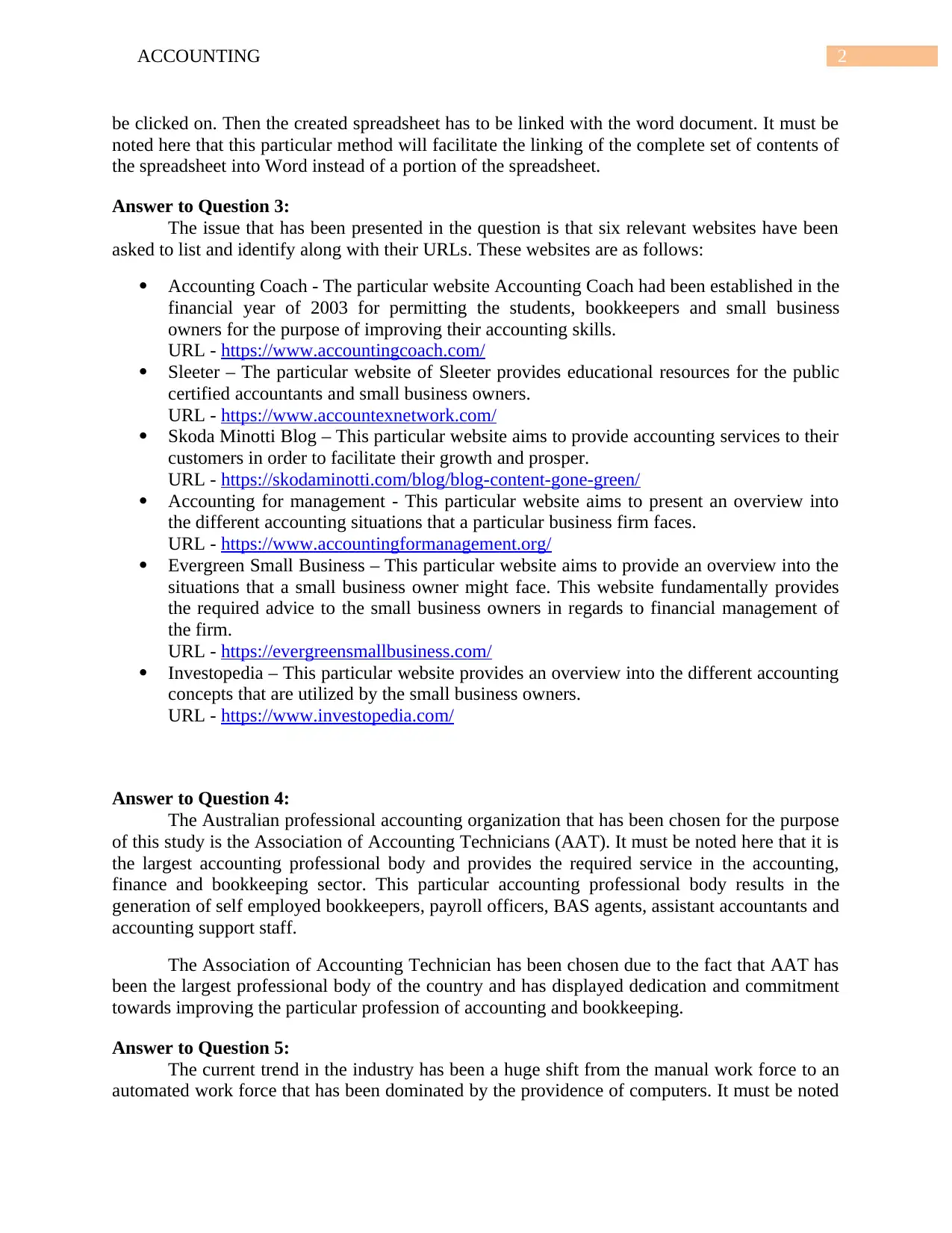
2ACCOUNTING
be clicked on. Then the created spreadsheet has to be linked with the word document. It must be
noted here that this particular method will facilitate the linking of the complete set of contents of
the spreadsheet into Word instead of a portion of the spreadsheet.
Answer to Question 3:
The issue that has been presented in the question is that six relevant websites have been
asked to list and identify along with their URLs. These websites are as follows:
Accounting Coach - The particular website Accounting Coach had been established in the
financial year of 2003 for permitting the students, bookkeepers and small business
owners for the purpose of improving their accounting skills.
URL - https://www.accountingcoach.com/
Sleeter – The particular website of Sleeter provides educational resources for the public
certified accountants and small business owners.
URL - https://www.accountexnetwork.com/
Skoda Minotti Blog – This particular website aims to provide accounting services to their
customers in order to facilitate their growth and prosper.
URL - https://skodaminotti.com/blog/blog-content-gone-green/
Accounting for management - This particular website aims to present an overview into
the different accounting situations that a particular business firm faces.
URL - https://www.accountingformanagement.org/
Evergreen Small Business – This particular website aims to provide an overview into the
situations that a small business owner might face. This website fundamentally provides
the required advice to the small business owners in regards to financial management of
the firm.
URL - https://evergreensmallbusiness.com/
Investopedia – This particular website provides an overview into the different accounting
concepts that are utilized by the small business owners.
URL - https://www.investopedia.com/
Answer to Question 4:
The Australian professional accounting organization that has been chosen for the purpose
of this study is the Association of Accounting Technicians (AAT). It must be noted here that it is
the largest accounting professional body and provides the required service in the accounting,
finance and bookkeeping sector. This particular accounting professional body results in the
generation of self employed bookkeepers, payroll officers, BAS agents, assistant accountants and
accounting support staff.
The Association of Accounting Technician has been chosen due to the fact that AAT has
been the largest professional body of the country and has displayed dedication and commitment
towards improving the particular profession of accounting and bookkeeping.
Answer to Question 5:
The current trend in the industry has been a huge shift from the manual work force to an
automated work force that has been dominated by the providence of computers. It must be noted
be clicked on. Then the created spreadsheet has to be linked with the word document. It must be
noted here that this particular method will facilitate the linking of the complete set of contents of
the spreadsheet into Word instead of a portion of the spreadsheet.
Answer to Question 3:
The issue that has been presented in the question is that six relevant websites have been
asked to list and identify along with their URLs. These websites are as follows:
Accounting Coach - The particular website Accounting Coach had been established in the
financial year of 2003 for permitting the students, bookkeepers and small business
owners for the purpose of improving their accounting skills.
URL - https://www.accountingcoach.com/
Sleeter – The particular website of Sleeter provides educational resources for the public
certified accountants and small business owners.
URL - https://www.accountexnetwork.com/
Skoda Minotti Blog – This particular website aims to provide accounting services to their
customers in order to facilitate their growth and prosper.
URL - https://skodaminotti.com/blog/blog-content-gone-green/
Accounting for management - This particular website aims to present an overview into
the different accounting situations that a particular business firm faces.
URL - https://www.accountingformanagement.org/
Evergreen Small Business – This particular website aims to provide an overview into the
situations that a small business owner might face. This website fundamentally provides
the required advice to the small business owners in regards to financial management of
the firm.
URL - https://evergreensmallbusiness.com/
Investopedia – This particular website provides an overview into the different accounting
concepts that are utilized by the small business owners.
URL - https://www.investopedia.com/
Answer to Question 4:
The Australian professional accounting organization that has been chosen for the purpose
of this study is the Association of Accounting Technicians (AAT). It must be noted here that it is
the largest accounting professional body and provides the required service in the accounting,
finance and bookkeeping sector. This particular accounting professional body results in the
generation of self employed bookkeepers, payroll officers, BAS agents, assistant accountants and
accounting support staff.
The Association of Accounting Technician has been chosen due to the fact that AAT has
been the largest professional body of the country and has displayed dedication and commitment
towards improving the particular profession of accounting and bookkeeping.
Answer to Question 5:
The current trend in the industry has been a huge shift from the manual work force to an
automated work force that has been dominated by the providence of computers. It must be noted
⊘ This is a preview!⊘
Do you want full access?
Subscribe today to unlock all pages.

Trusted by 1+ million students worldwide
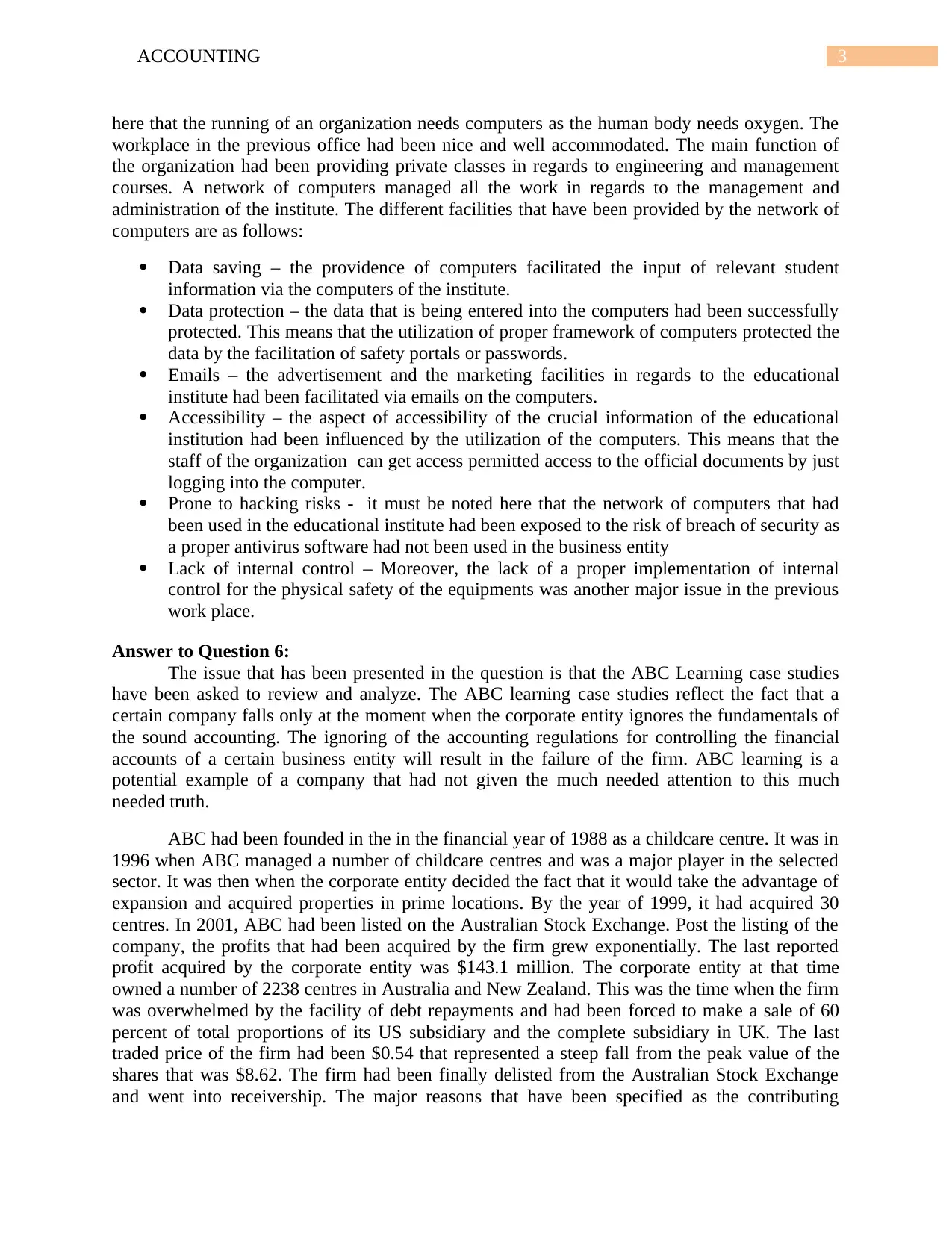
3ACCOUNTING
here that the running of an organization needs computers as the human body needs oxygen. The
workplace in the previous office had been nice and well accommodated. The main function of
the organization had been providing private classes in regards to engineering and management
courses. A network of computers managed all the work in regards to the management and
administration of the institute. The different facilities that have been provided by the network of
computers are as follows:
Data saving – the providence of computers facilitated the input of relevant student
information via the computers of the institute.
Data protection – the data that is being entered into the computers had been successfully
protected. This means that the utilization of proper framework of computers protected the
data by the facilitation of safety portals or passwords.
Emails – the advertisement and the marketing facilities in regards to the educational
institute had been facilitated via emails on the computers.
Accessibility – the aspect of accessibility of the crucial information of the educational
institution had been influenced by the utilization of the computers. This means that the
staff of the organization can get access permitted access to the official documents by just
logging into the computer.
Prone to hacking risks - it must be noted here that the network of computers that had
been used in the educational institute had been exposed to the risk of breach of security as
a proper antivirus software had not been used in the business entity
Lack of internal control – Moreover, the lack of a proper implementation of internal
control for the physical safety of the equipments was another major issue in the previous
work place.
Answer to Question 6:
The issue that has been presented in the question is that the ABC Learning case studies
have been asked to review and analyze. The ABC learning case studies reflect the fact that a
certain company falls only at the moment when the corporate entity ignores the fundamentals of
the sound accounting. The ignoring of the accounting regulations for controlling the financial
accounts of a certain business entity will result in the failure of the firm. ABC learning is a
potential example of a company that had not given the much needed attention to this much
needed truth.
ABC had been founded in the in the financial year of 1988 as a childcare centre. It was in
1996 when ABC managed a number of childcare centres and was a major player in the selected
sector. It was then when the corporate entity decided the fact that it would take the advantage of
expansion and acquired properties in prime locations. By the year of 1999, it had acquired 30
centres. In 2001, ABC had been listed on the Australian Stock Exchange. Post the listing of the
company, the profits that had been acquired by the firm grew exponentially. The last reported
profit acquired by the corporate entity was $143.1 million. The corporate entity at that time
owned a number of 2238 centres in Australia and New Zealand. This was the time when the firm
was overwhelmed by the facility of debt repayments and had been forced to make a sale of 60
percent of total proportions of its US subsidiary and the complete subsidiary in UK. The last
traded price of the firm had been $0.54 that represented a steep fall from the peak value of the
shares that was $8.62. The firm had been finally delisted from the Australian Stock Exchange
and went into receivership. The major reasons that have been specified as the contributing
here that the running of an organization needs computers as the human body needs oxygen. The
workplace in the previous office had been nice and well accommodated. The main function of
the organization had been providing private classes in regards to engineering and management
courses. A network of computers managed all the work in regards to the management and
administration of the institute. The different facilities that have been provided by the network of
computers are as follows:
Data saving – the providence of computers facilitated the input of relevant student
information via the computers of the institute.
Data protection – the data that is being entered into the computers had been successfully
protected. This means that the utilization of proper framework of computers protected the
data by the facilitation of safety portals or passwords.
Emails – the advertisement and the marketing facilities in regards to the educational
institute had been facilitated via emails on the computers.
Accessibility – the aspect of accessibility of the crucial information of the educational
institution had been influenced by the utilization of the computers. This means that the
staff of the organization can get access permitted access to the official documents by just
logging into the computer.
Prone to hacking risks - it must be noted here that the network of computers that had
been used in the educational institute had been exposed to the risk of breach of security as
a proper antivirus software had not been used in the business entity
Lack of internal control – Moreover, the lack of a proper implementation of internal
control for the physical safety of the equipments was another major issue in the previous
work place.
Answer to Question 6:
The issue that has been presented in the question is that the ABC Learning case studies
have been asked to review and analyze. The ABC learning case studies reflect the fact that a
certain company falls only at the moment when the corporate entity ignores the fundamentals of
the sound accounting. The ignoring of the accounting regulations for controlling the financial
accounts of a certain business entity will result in the failure of the firm. ABC learning is a
potential example of a company that had not given the much needed attention to this much
needed truth.
ABC had been founded in the in the financial year of 1988 as a childcare centre. It was in
1996 when ABC managed a number of childcare centres and was a major player in the selected
sector. It was then when the corporate entity decided the fact that it would take the advantage of
expansion and acquired properties in prime locations. By the year of 1999, it had acquired 30
centres. In 2001, ABC had been listed on the Australian Stock Exchange. Post the listing of the
company, the profits that had been acquired by the firm grew exponentially. The last reported
profit acquired by the corporate entity was $143.1 million. The corporate entity at that time
owned a number of 2238 centres in Australia and New Zealand. This was the time when the firm
was overwhelmed by the facility of debt repayments and had been forced to make a sale of 60
percent of total proportions of its US subsidiary and the complete subsidiary in UK. The last
traded price of the firm had been $0.54 that represented a steep fall from the peak value of the
shares that was $8.62. The firm had been finally delisted from the Australian Stock Exchange
and went into receivership. The major reasons that have been specified as the contributing
Paraphrase This Document
Need a fresh take? Get an instant paraphrase of this document with our AI Paraphraser
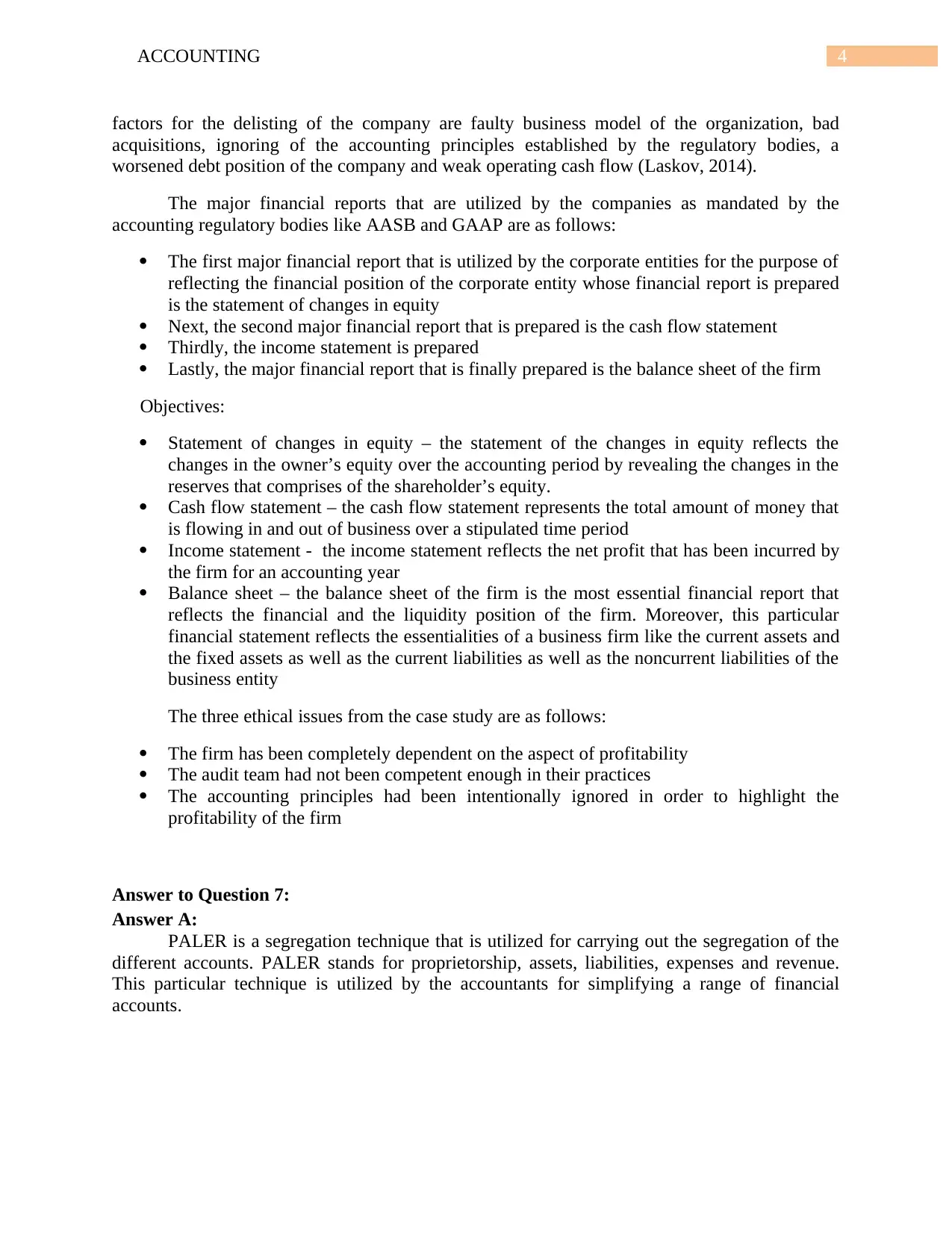
4ACCOUNTING
factors for the delisting of the company are faulty business model of the organization, bad
acquisitions, ignoring of the accounting principles established by the regulatory bodies, a
worsened debt position of the company and weak operating cash flow (Laskov, 2014).
The major financial reports that are utilized by the companies as mandated by the
accounting regulatory bodies like AASB and GAAP are as follows:
The first major financial report that is utilized by the corporate entities for the purpose of
reflecting the financial position of the corporate entity whose financial report is prepared
is the statement of changes in equity
Next, the second major financial report that is prepared is the cash flow statement
Thirdly, the income statement is prepared
Lastly, the major financial report that is finally prepared is the balance sheet of the firm
Objectives:
Statement of changes in equity – the statement of the changes in equity reflects the
changes in the owner’s equity over the accounting period by revealing the changes in the
reserves that comprises of the shareholder’s equity.
Cash flow statement – the cash flow statement represents the total amount of money that
is flowing in and out of business over a stipulated time period
Income statement - the income statement reflects the net profit that has been incurred by
the firm for an accounting year
Balance sheet – the balance sheet of the firm is the most essential financial report that
reflects the financial and the liquidity position of the firm. Moreover, this particular
financial statement reflects the essentialities of a business firm like the current assets and
the fixed assets as well as the current liabilities as well as the noncurrent liabilities of the
business entity
The three ethical issues from the case study are as follows:
The firm has been completely dependent on the aspect of profitability
The audit team had not been competent enough in their practices
The accounting principles had been intentionally ignored in order to highlight the
profitability of the firm
Answer to Question 7:
Answer A:
PALER is a segregation technique that is utilized for carrying out the segregation of the
different accounts. PALER stands for proprietorship, assets, liabilities, expenses and revenue.
This particular technique is utilized by the accountants for simplifying a range of financial
accounts.
factors for the delisting of the company are faulty business model of the organization, bad
acquisitions, ignoring of the accounting principles established by the regulatory bodies, a
worsened debt position of the company and weak operating cash flow (Laskov, 2014).
The major financial reports that are utilized by the companies as mandated by the
accounting regulatory bodies like AASB and GAAP are as follows:
The first major financial report that is utilized by the corporate entities for the purpose of
reflecting the financial position of the corporate entity whose financial report is prepared
is the statement of changes in equity
Next, the second major financial report that is prepared is the cash flow statement
Thirdly, the income statement is prepared
Lastly, the major financial report that is finally prepared is the balance sheet of the firm
Objectives:
Statement of changes in equity – the statement of the changes in equity reflects the
changes in the owner’s equity over the accounting period by revealing the changes in the
reserves that comprises of the shareholder’s equity.
Cash flow statement – the cash flow statement represents the total amount of money that
is flowing in and out of business over a stipulated time period
Income statement - the income statement reflects the net profit that has been incurred by
the firm for an accounting year
Balance sheet – the balance sheet of the firm is the most essential financial report that
reflects the financial and the liquidity position of the firm. Moreover, this particular
financial statement reflects the essentialities of a business firm like the current assets and
the fixed assets as well as the current liabilities as well as the noncurrent liabilities of the
business entity
The three ethical issues from the case study are as follows:
The firm has been completely dependent on the aspect of profitability
The audit team had not been competent enough in their practices
The accounting principles had been intentionally ignored in order to highlight the
profitability of the firm
Answer to Question 7:
Answer A:
PALER is a segregation technique that is utilized for carrying out the segregation of the
different accounts. PALER stands for proprietorship, assets, liabilities, expenses and revenue.
This particular technique is utilized by the accountants for simplifying a range of financial
accounts.
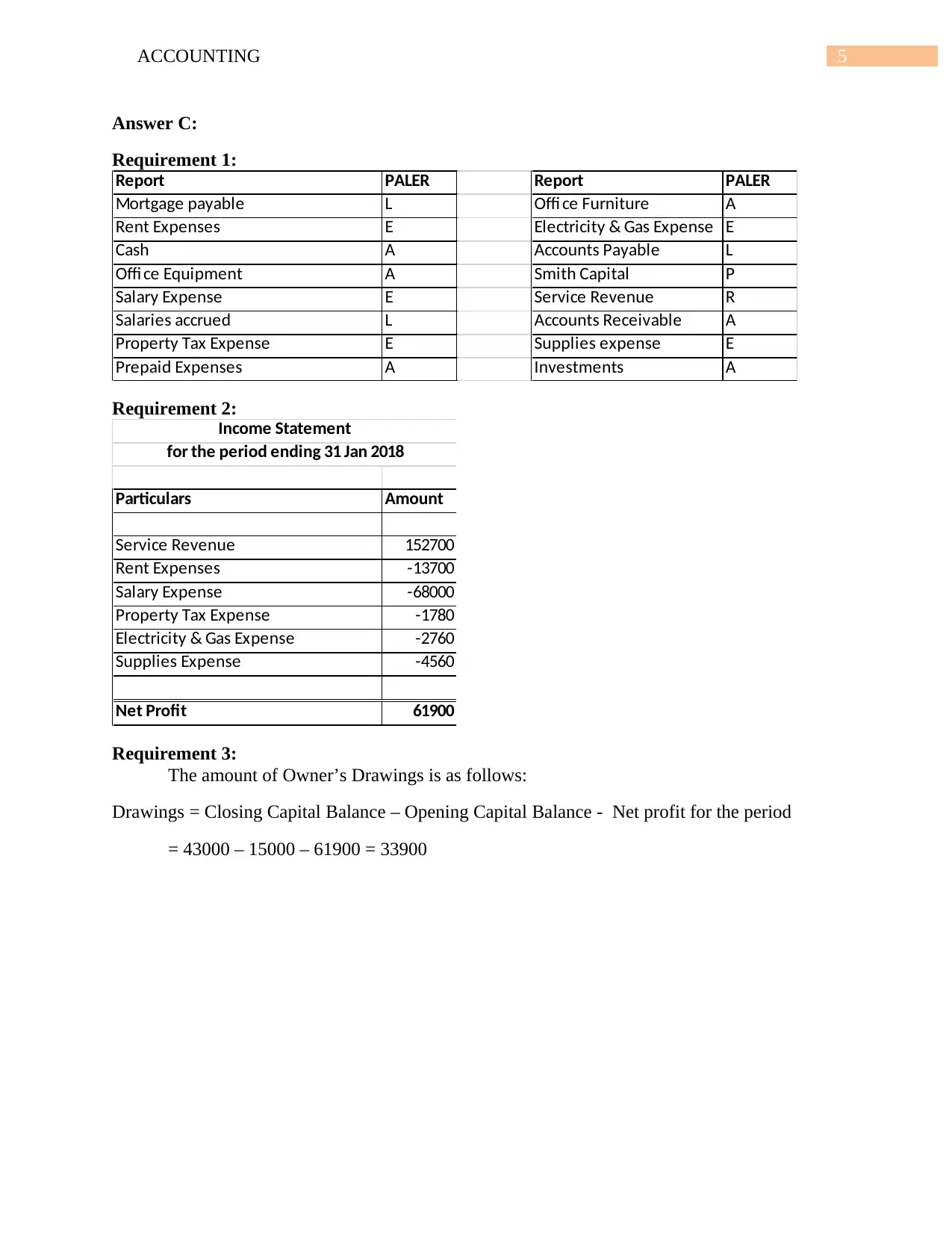
5ACCOUNTING
Answer C:
Requirement 1:
Report PALER Report PALER
Mortgage payable L Offi ce Furniture A
Rent Expenses E Electricity & Gas Expense E
Cash A Accounts Payable L
Offi ce Equipment A Smith Capital P
Salary Expense E Service Revenue R
Salaries accrued L Accounts Receivable A
Property Tax Expense E Supplies expense E
Prepaid Expenses A Investments A
Requirement 2:
Particulars Amount
Service Revenue 152700
Rent Expenses -13700
Salary Expense -68000
Property Tax Expense -1780
Electricity & Gas Expense -2760
Supplies Expense -4560
Net Profit 61900
Income Statement
for the period ending 31 Jan 2018
Requirement 3:
The amount of Owner’s Drawings is as follows:
Drawings = Closing Capital Balance – Opening Capital Balance - Net profit for the period
= 43000 – 15000 – 61900 = 33900
Answer C:
Requirement 1:
Report PALER Report PALER
Mortgage payable L Offi ce Furniture A
Rent Expenses E Electricity & Gas Expense E
Cash A Accounts Payable L
Offi ce Equipment A Smith Capital P
Salary Expense E Service Revenue R
Salaries accrued L Accounts Receivable A
Property Tax Expense E Supplies expense E
Prepaid Expenses A Investments A
Requirement 2:
Particulars Amount
Service Revenue 152700
Rent Expenses -13700
Salary Expense -68000
Property Tax Expense -1780
Electricity & Gas Expense -2760
Supplies Expense -4560
Net Profit 61900
Income Statement
for the period ending 31 Jan 2018
Requirement 3:
The amount of Owner’s Drawings is as follows:
Drawings = Closing Capital Balance – Opening Capital Balance - Net profit for the period
= 43000 – 15000 – 61900 = 33900
⊘ This is a preview!⊘
Do you want full access?
Subscribe today to unlock all pages.

Trusted by 1+ million students worldwide
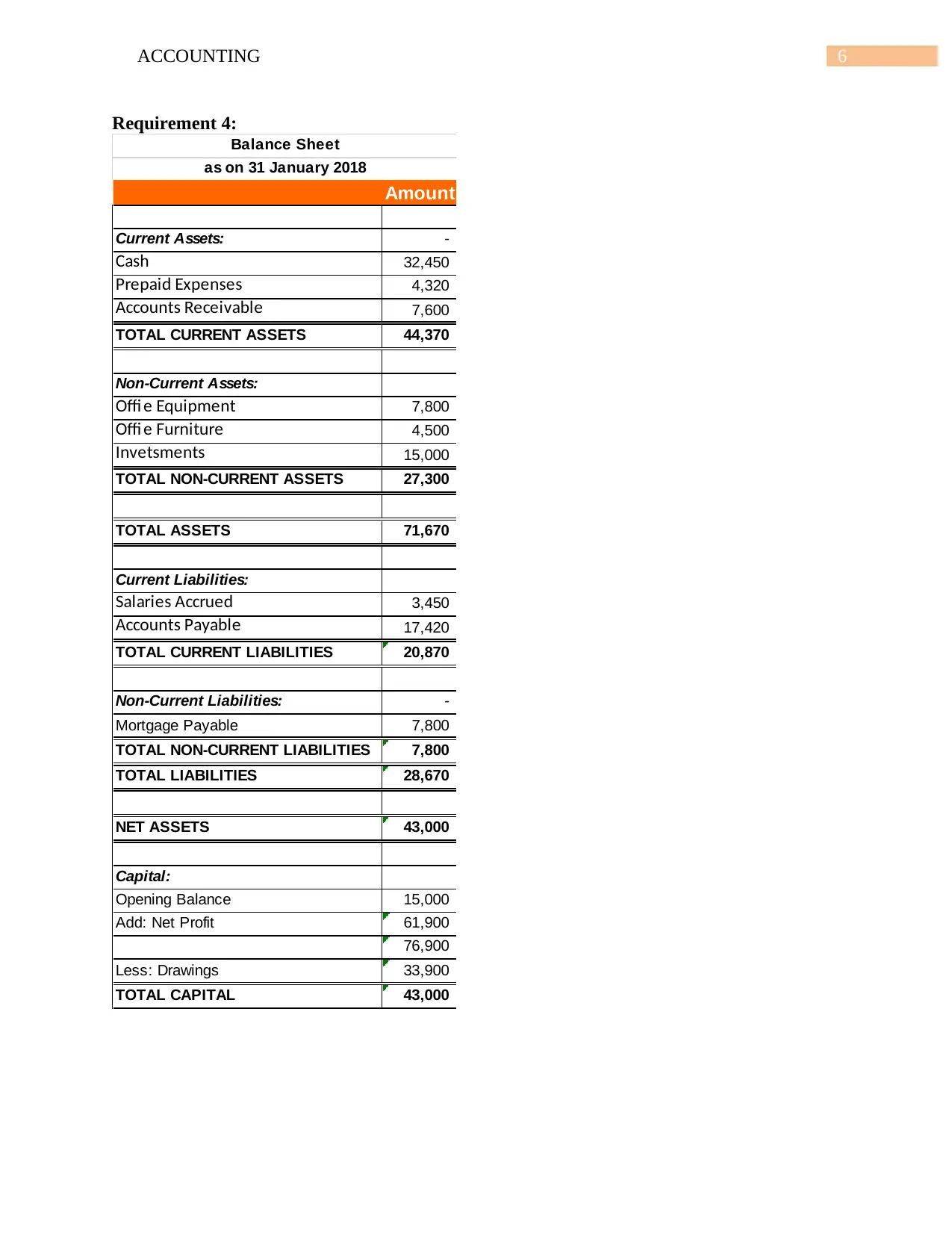
6ACCOUNTING
Requirement 4:
Amount
Current Assets: -
Cash 32,450
Prepaid Expenses 4,320
Accounts Receivable 7,600
TOTAL CURRENT ASSETS 44,370
Non-Current Assets:
Offi e Equipment 7,800
Offi e Furniture 4,500
Invetsments 15,000
TOTAL NON-CURRENT ASSETS 27,300
TOTAL ASSETS 71,670
Current Liabilities:
Salaries Accrued 3,450
Accounts Payable 17,420
TOTAL CURRENT LIABILITIES 20,870
Non-Current Liabilities: -
Mortgage Payable 7,800
TOTAL NON-CURRENT LIABILITIES 7,800
TOTAL LIABILITIES 28,670
NET ASSETS 43,000
Capital:
Opening Balance 15,000
Add: Net Profit 61,900
76,900
Less: Drawings 33,900
TOTAL CAPITAL 43,000
Balance Sheet
as on 31 January 2018
Requirement 4:
Amount
Current Assets: -
Cash 32,450
Prepaid Expenses 4,320
Accounts Receivable 7,600
TOTAL CURRENT ASSETS 44,370
Non-Current Assets:
Offi e Equipment 7,800
Offi e Furniture 4,500
Invetsments 15,000
TOTAL NON-CURRENT ASSETS 27,300
TOTAL ASSETS 71,670
Current Liabilities:
Salaries Accrued 3,450
Accounts Payable 17,420
TOTAL CURRENT LIABILITIES 20,870
Non-Current Liabilities: -
Mortgage Payable 7,800
TOTAL NON-CURRENT LIABILITIES 7,800
TOTAL LIABILITIES 28,670
NET ASSETS 43,000
Capital:
Opening Balance 15,000
Add: Net Profit 61,900
76,900
Less: Drawings 33,900
TOTAL CAPITAL 43,000
Balance Sheet
as on 31 January 2018
Paraphrase This Document
Need a fresh take? Get an instant paraphrase of this document with our AI Paraphraser
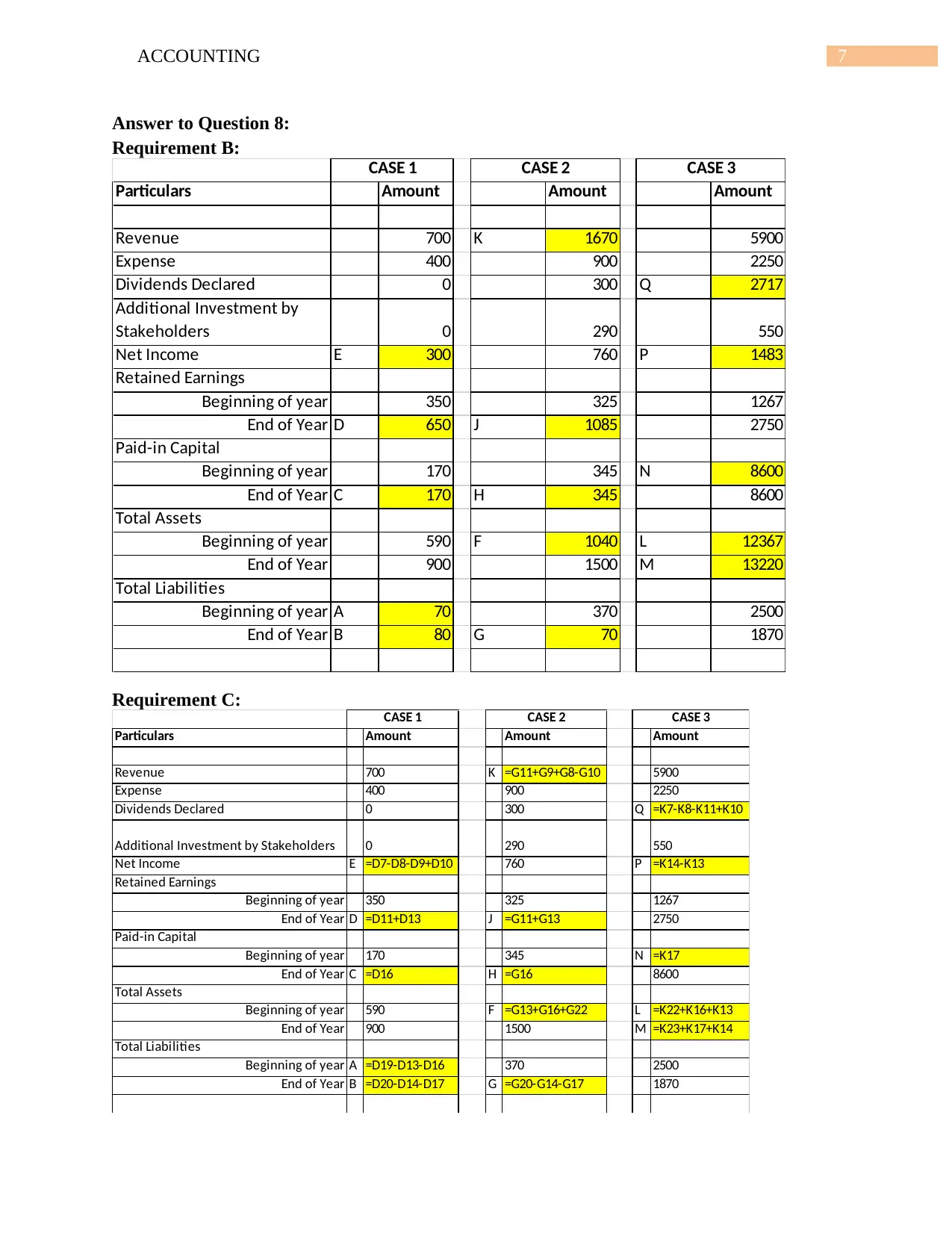
7ACCOUNTING
Answer to Question 8:
Requirement B:
Particulars Amount Amount Amount
Revenue 700 K 1670 5900
Expense 400 900 2250
Dividends Declared 0 300 Q 2717
Additional Investment by
Stakeholders 0 290 550
Net Income E 300 760 P 1483
Retained Earnings
Beginning of year 350 325 1267
End of Year D 650 J 1085 2750
Paid-in Capital
Beginning of year 170 345 N 8600
End of Year C 170 H 345 8600
Total Assets
Beginning of year 590 F 1040 L 12367
End of Year 900 1500 M 13220
Total Liabilities
Beginning of year A 70 370 2500
End of Year B 80 G 70 1870
CASE 1 CASE 3CASE 2
Requirement C:
Particulars Amount Amount Amount
Revenue 700 K =G11+G9+G8-G10 5900
Expense 400 900 2250
Dividends Declared 0 300 Q =K7-K8-K11+K10
Additional Investment by Stakeholders 0 290 550
Net Income E =D7-D8-D9+D10 760 P =K14-K13
Retained Earnings
Beginning of year 350 325 1267
End of Year D =D11+D13 J =G11+G13 2750
Paid-in Capital
Beginning of year 170 345 N =K17
End of Year C =D16 H =G16 8600
Total Assets
Beginning of year 590 F =G13+G16+G22 L =K22+K16+K13
End of Year 900 1500 M =K23+K17+K14
Total Liabilities
Beginning of year A =D19-D13-D16 370 2500
End of Year B =D20-D14-D17 G =G20-G14-G17 1870
CASE 1 CASE 2 CASE 3
Answer to Question 8:
Requirement B:
Particulars Amount Amount Amount
Revenue 700 K 1670 5900
Expense 400 900 2250
Dividends Declared 0 300 Q 2717
Additional Investment by
Stakeholders 0 290 550
Net Income E 300 760 P 1483
Retained Earnings
Beginning of year 350 325 1267
End of Year D 650 J 1085 2750
Paid-in Capital
Beginning of year 170 345 N 8600
End of Year C 170 H 345 8600
Total Assets
Beginning of year 590 F 1040 L 12367
End of Year 900 1500 M 13220
Total Liabilities
Beginning of year A 70 370 2500
End of Year B 80 G 70 1870
CASE 1 CASE 3CASE 2
Requirement C:
Particulars Amount Amount Amount
Revenue 700 K =G11+G9+G8-G10 5900
Expense 400 900 2250
Dividends Declared 0 300 Q =K7-K8-K11+K10
Additional Investment by Stakeholders 0 290 550
Net Income E =D7-D8-D9+D10 760 P =K14-K13
Retained Earnings
Beginning of year 350 325 1267
End of Year D =D11+D13 J =G11+G13 2750
Paid-in Capital
Beginning of year 170 345 N =K17
End of Year C =D16 H =G16 8600
Total Assets
Beginning of year 590 F =G13+G16+G22 L =K22+K16+K13
End of Year 900 1500 M =K23+K17+K14
Total Liabilities
Beginning of year A =D19-D13-D16 370 2500
End of Year B =D20-D14-D17 G =G20-G14-G17 1870
CASE 1 CASE 2 CASE 3
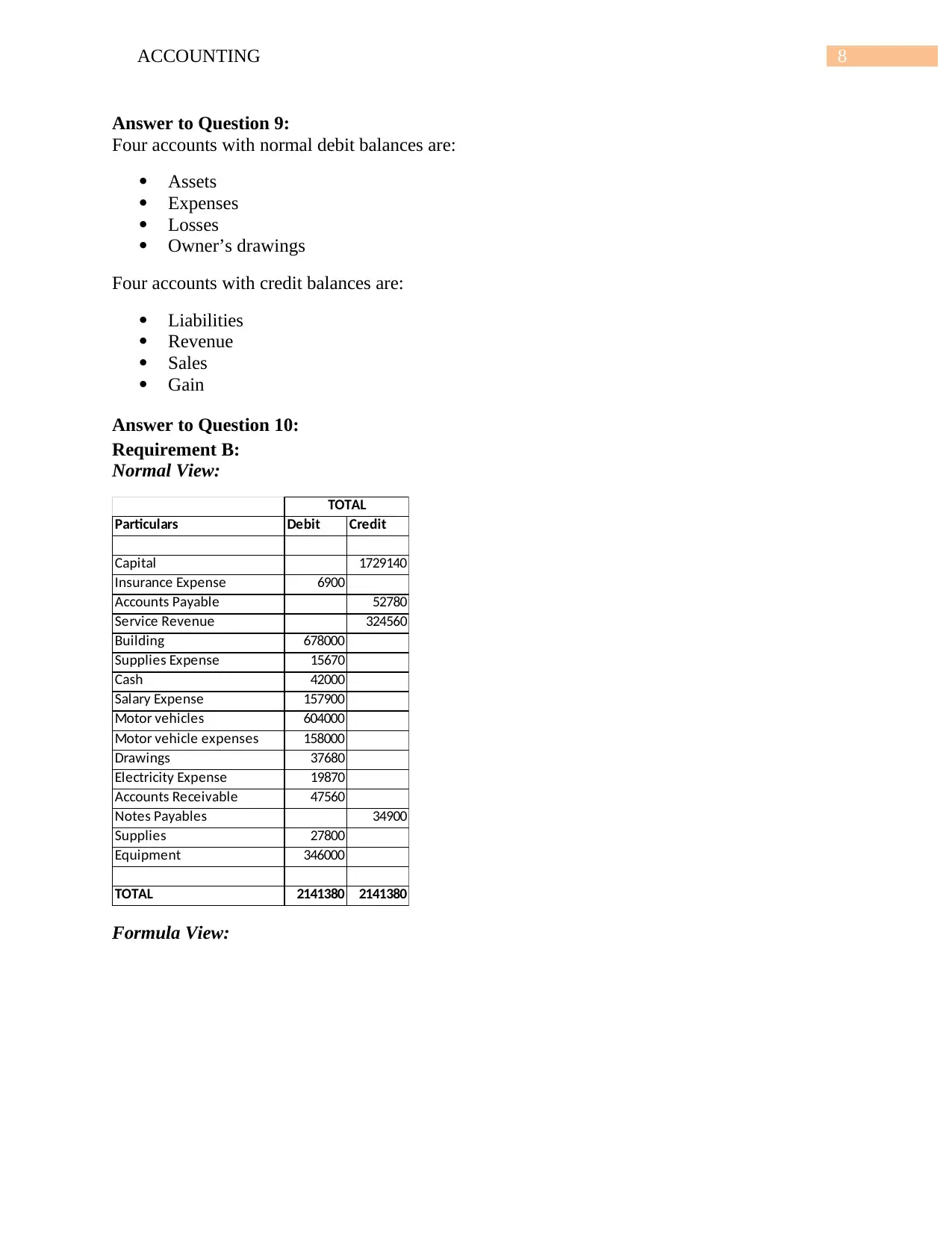
8ACCOUNTING
Answer to Question 9:
Four accounts with normal debit balances are:
Assets
Expenses
Losses
Owner’s drawings
Four accounts with credit balances are:
Liabilities
Revenue
Sales
Gain
Answer to Question 10:
Requirement B:
Normal View:
Particulars Debit Credit
Capital 1729140
Insurance Expense 6900
Accounts Payable 52780
Service Revenue 324560
Building 678000
Supplies Expense 15670
Cash 42000
Salary Expense 157900
Motor vehicles 604000
Motor vehicle expenses 158000
Drawings 37680
Electricity Expense 19870
Accounts Receivable 47560
Notes Payables 34900
Supplies 27800
Equipment 346000
TOTAL 2141380 2141380
TOTAL
Formula View:
Answer to Question 9:
Four accounts with normal debit balances are:
Assets
Expenses
Losses
Owner’s drawings
Four accounts with credit balances are:
Liabilities
Revenue
Sales
Gain
Answer to Question 10:
Requirement B:
Normal View:
Particulars Debit Credit
Capital 1729140
Insurance Expense 6900
Accounts Payable 52780
Service Revenue 324560
Building 678000
Supplies Expense 15670
Cash 42000
Salary Expense 157900
Motor vehicles 604000
Motor vehicle expenses 158000
Drawings 37680
Electricity Expense 19870
Accounts Receivable 47560
Notes Payables 34900
Supplies 27800
Equipment 346000
TOTAL 2141380 2141380
TOTAL
Formula View:
⊘ This is a preview!⊘
Do you want full access?
Subscribe today to unlock all pages.

Trusted by 1+ million students worldwide
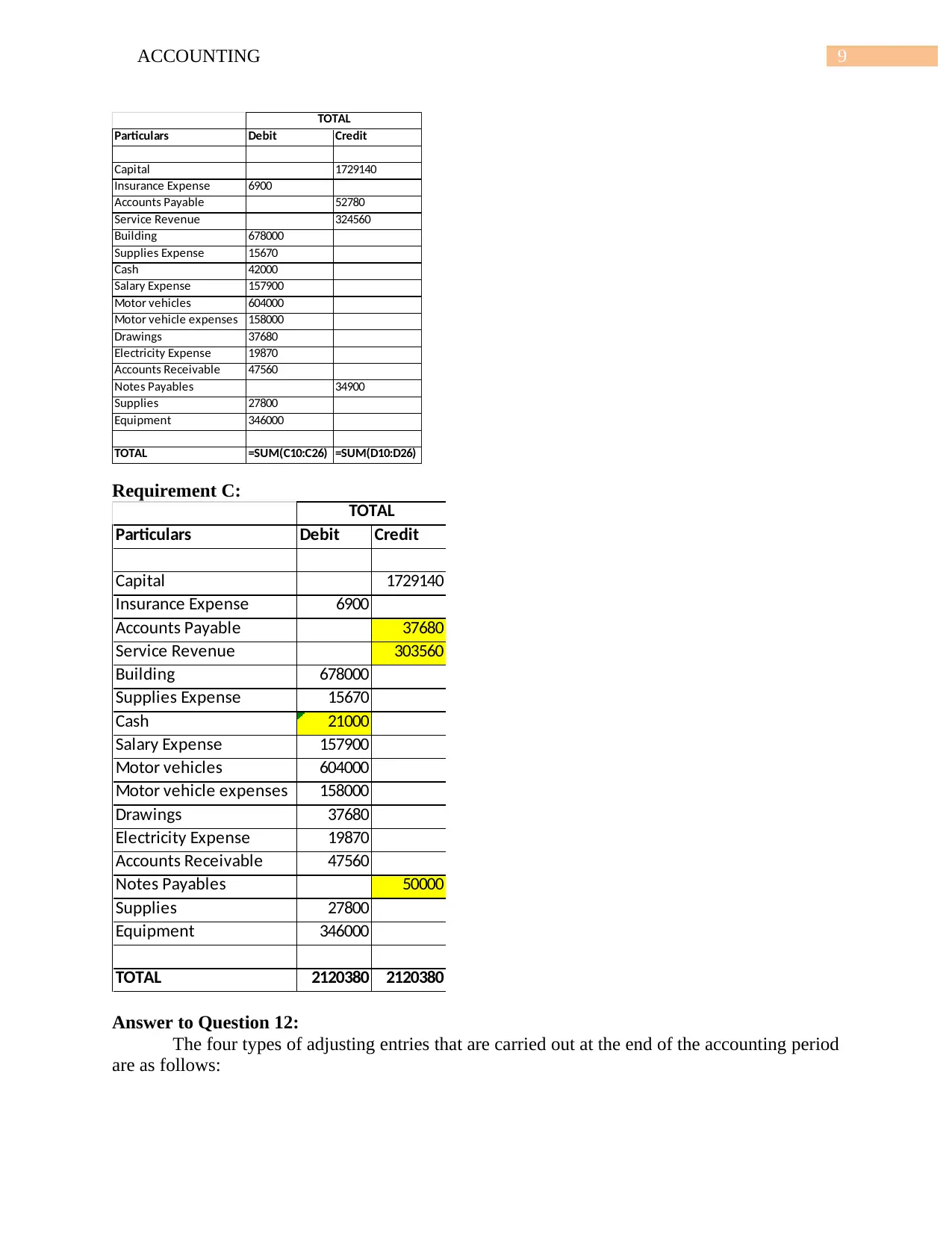
9ACCOUNTING
Particulars Debit Credit
Capital 1729140
Insurance Expense 6900
Accounts Payable 52780
Service Revenue 324560
Building 678000
Supplies Expense 15670
Cash 42000
Salary Expense 157900
Motor vehicles 604000
Motor vehicle expenses 158000
Drawings 37680
Electricity Expense 19870
Accounts Receivable 47560
Notes Payables 34900
Supplies 27800
Equipment 346000
TOTAL =SUM(C10:C26) =SUM(D10:D26)
TOTAL
Requirement C:
Particulars Debit Credit
Capital 1729140
Insurance Expense 6900
Accounts Payable 37680
Service Revenue 303560
Building 678000
Supplies Expense 15670
Cash 21000
Salary Expense 157900
Motor vehicles 604000
Motor vehicle expenses 158000
Drawings 37680
Electricity Expense 19870
Accounts Receivable 47560
Notes Payables 50000
Supplies 27800
Equipment 346000
TOTAL 2120380 2120380
TOTAL
Answer to Question 12:
The four types of adjusting entries that are carried out at the end of the accounting period
are as follows:
Particulars Debit Credit
Capital 1729140
Insurance Expense 6900
Accounts Payable 52780
Service Revenue 324560
Building 678000
Supplies Expense 15670
Cash 42000
Salary Expense 157900
Motor vehicles 604000
Motor vehicle expenses 158000
Drawings 37680
Electricity Expense 19870
Accounts Receivable 47560
Notes Payables 34900
Supplies 27800
Equipment 346000
TOTAL =SUM(C10:C26) =SUM(D10:D26)
TOTAL
Requirement C:
Particulars Debit Credit
Capital 1729140
Insurance Expense 6900
Accounts Payable 37680
Service Revenue 303560
Building 678000
Supplies Expense 15670
Cash 21000
Salary Expense 157900
Motor vehicles 604000
Motor vehicle expenses 158000
Drawings 37680
Electricity Expense 19870
Accounts Receivable 47560
Notes Payables 50000
Supplies 27800
Equipment 346000
TOTAL 2120380 2120380
TOTAL
Answer to Question 12:
The four types of adjusting entries that are carried out at the end of the accounting period
are as follows:
Paraphrase This Document
Need a fresh take? Get an instant paraphrase of this document with our AI Paraphraser
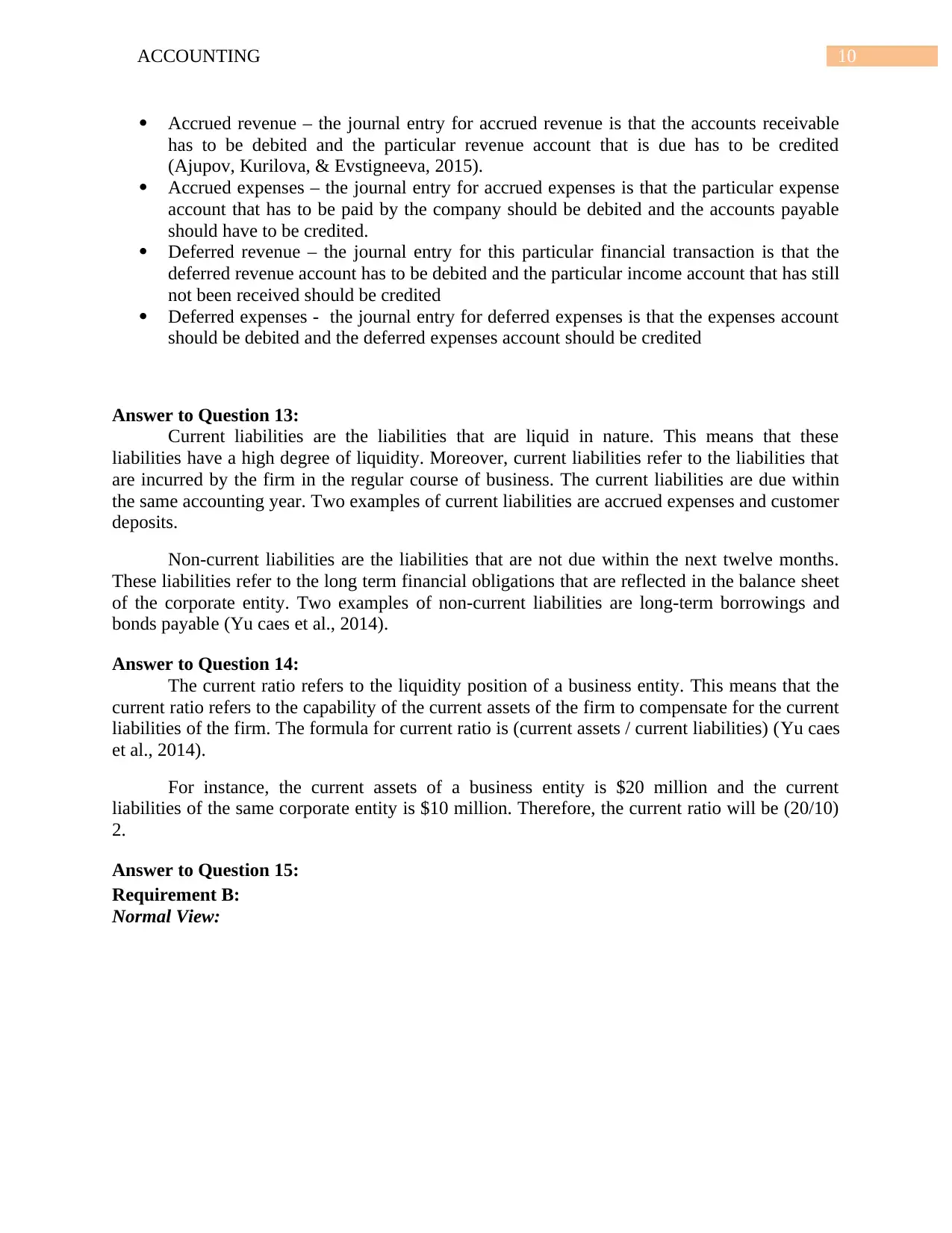
10ACCOUNTING
Accrued revenue – the journal entry for accrued revenue is that the accounts receivable
has to be debited and the particular revenue account that is due has to be credited
(Ajupov, Kurilova, & Evstigneeva, 2015).
Accrued expenses – the journal entry for accrued expenses is that the particular expense
account that has to be paid by the company should be debited and the accounts payable
should have to be credited.
Deferred revenue – the journal entry for this particular financial transaction is that the
deferred revenue account has to be debited and the particular income account that has still
not been received should be credited
Deferred expenses - the journal entry for deferred expenses is that the expenses account
should be debited and the deferred expenses account should be credited
Answer to Question 13:
Current liabilities are the liabilities that are liquid in nature. This means that these
liabilities have a high degree of liquidity. Moreover, current liabilities refer to the liabilities that
are incurred by the firm in the regular course of business. The current liabilities are due within
the same accounting year. Two examples of current liabilities are accrued expenses and customer
deposits.
Non-current liabilities are the liabilities that are not due within the next twelve months.
These liabilities refer to the long term financial obligations that are reflected in the balance sheet
of the corporate entity. Two examples of non-current liabilities are long-term borrowings and
bonds payable (Yu caes et al., 2014).
Answer to Question 14:
The current ratio refers to the liquidity position of a business entity. This means that the
current ratio refers to the capability of the current assets of the firm to compensate for the current
liabilities of the firm. The formula for current ratio is (current assets / current liabilities) (Yu caes
et al., 2014).
For instance, the current assets of a business entity is $20 million and the current
liabilities of the same corporate entity is $10 million. Therefore, the current ratio will be (20/10)
2.
Answer to Question 15:
Requirement B:
Normal View:
Accrued revenue – the journal entry for accrued revenue is that the accounts receivable
has to be debited and the particular revenue account that is due has to be credited
(Ajupov, Kurilova, & Evstigneeva, 2015).
Accrued expenses – the journal entry for accrued expenses is that the particular expense
account that has to be paid by the company should be debited and the accounts payable
should have to be credited.
Deferred revenue – the journal entry for this particular financial transaction is that the
deferred revenue account has to be debited and the particular income account that has still
not been received should be credited
Deferred expenses - the journal entry for deferred expenses is that the expenses account
should be debited and the deferred expenses account should be credited
Answer to Question 13:
Current liabilities are the liabilities that are liquid in nature. This means that these
liabilities have a high degree of liquidity. Moreover, current liabilities refer to the liabilities that
are incurred by the firm in the regular course of business. The current liabilities are due within
the same accounting year. Two examples of current liabilities are accrued expenses and customer
deposits.
Non-current liabilities are the liabilities that are not due within the next twelve months.
These liabilities refer to the long term financial obligations that are reflected in the balance sheet
of the corporate entity. Two examples of non-current liabilities are long-term borrowings and
bonds payable (Yu caes et al., 2014).
Answer to Question 14:
The current ratio refers to the liquidity position of a business entity. This means that the
current ratio refers to the capability of the current assets of the firm to compensate for the current
liabilities of the firm. The formula for current ratio is (current assets / current liabilities) (Yu caes
et al., 2014).
For instance, the current assets of a business entity is $20 million and the current
liabilities of the same corporate entity is $10 million. Therefore, the current ratio will be (20/10)
2.
Answer to Question 15:
Requirement B:
Normal View:
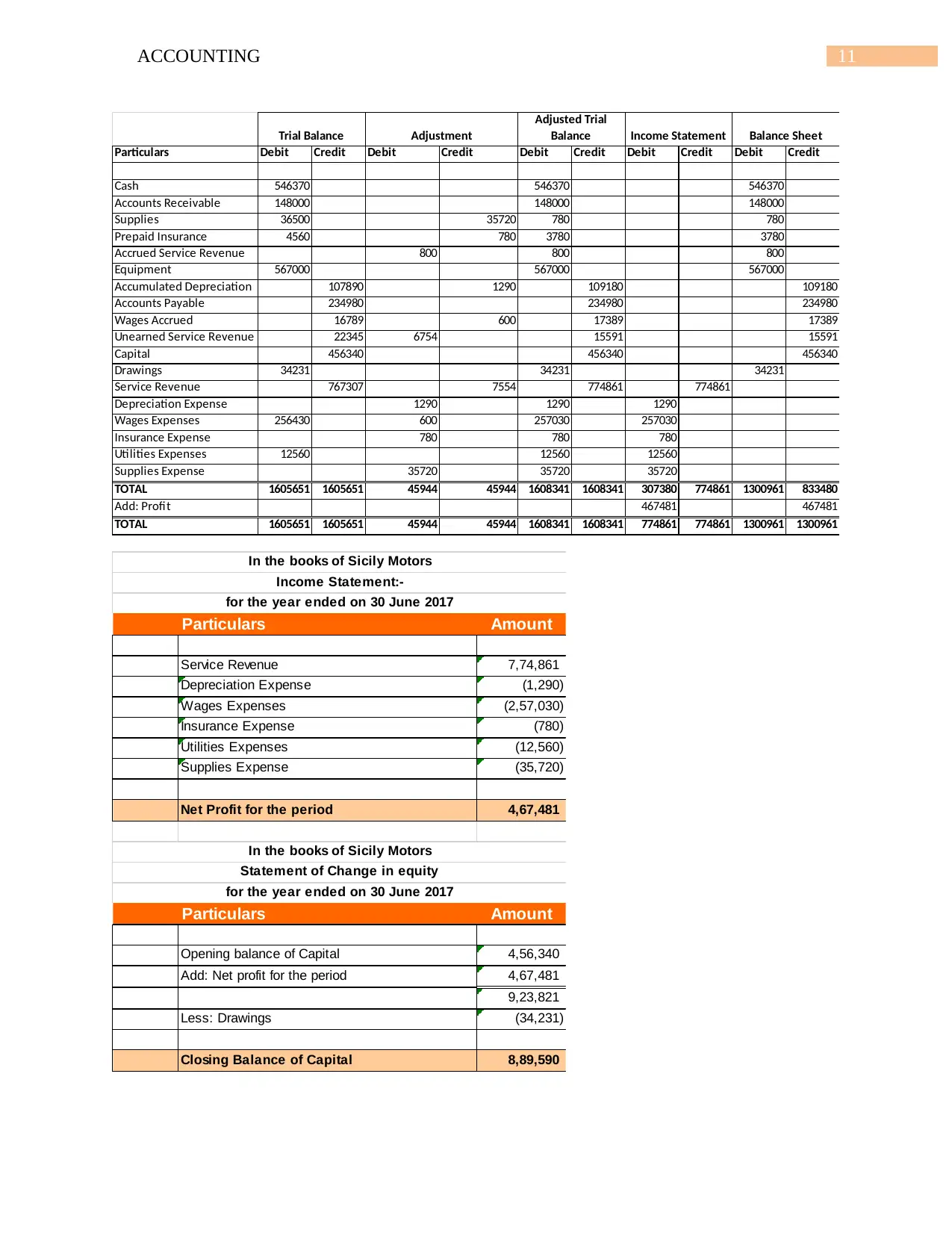
11ACCOUNTING
Particulars Debit Credit Debit Credit Debit Credit Debit Credit Debit Credit
Cash 546370 546370 546370
Accounts Receivable 148000 148000 148000
Supplies 36500 35720 780 780
Prepaid Insurance 4560 780 3780 3780
Accrued Service Revenue 800 800 800
Equipment 567000 567000 567000
Accumulated Depreciation 107890 1290 109180 109180
Accounts Payable 234980 234980 234980
Wages Accrued 16789 600 17389 17389
Unearned Service Revenue 22345 6754 15591 15591
Capital 456340 456340 456340
Drawings 34231 34231 34231
Service Revenue 767307 7554 774861 774861
Depreciation Expense 1290 1290 1290
Wages Expenses 256430 600 257030 257030
Insurance Expense 780 780 780
Utilities Expenses 12560 12560 12560
Supplies Expense 35720 35720 35720
TOTAL 1605651 1605651 45944 45944 1608341 1608341 307380 774861 1300961 833480
Add: Profit 467481 467481
TOTAL 1605651 1605651 45944 45944 1608341 1608341 774861 774861 1300961 1300961
Adjusted Trial
Balance Income Statement Balance SheetTrial Balance Adjustment
Particulars Amount
Service Revenue 7,74,861
Depreciation Expense (1,290)
Wages Expenses (2,57,030)
Insurance Expense (780)
Utilities Expenses (12,560)
Supplies Expense (35,720)
Net Profit for the period 4,67,481
Particulars Amount
Opening balance of Capital 4,56,340
Add: Net profit for the period 4,67,481
9,23,821
Less: Drawings (34,231)
Closing Balance of Capital 8,89,590
for the year ended on 30 June 2017
In the books of Sicily Motors
Income Statement:-
for the year ended on 30 June 2017
In the books of Sicily Motors
Statement of Change in equity
Particulars Debit Credit Debit Credit Debit Credit Debit Credit Debit Credit
Cash 546370 546370 546370
Accounts Receivable 148000 148000 148000
Supplies 36500 35720 780 780
Prepaid Insurance 4560 780 3780 3780
Accrued Service Revenue 800 800 800
Equipment 567000 567000 567000
Accumulated Depreciation 107890 1290 109180 109180
Accounts Payable 234980 234980 234980
Wages Accrued 16789 600 17389 17389
Unearned Service Revenue 22345 6754 15591 15591
Capital 456340 456340 456340
Drawings 34231 34231 34231
Service Revenue 767307 7554 774861 774861
Depreciation Expense 1290 1290 1290
Wages Expenses 256430 600 257030 257030
Insurance Expense 780 780 780
Utilities Expenses 12560 12560 12560
Supplies Expense 35720 35720 35720
TOTAL 1605651 1605651 45944 45944 1608341 1608341 307380 774861 1300961 833480
Add: Profit 467481 467481
TOTAL 1605651 1605651 45944 45944 1608341 1608341 774861 774861 1300961 1300961
Adjusted Trial
Balance Income Statement Balance SheetTrial Balance Adjustment
Particulars Amount
Service Revenue 7,74,861
Depreciation Expense (1,290)
Wages Expenses (2,57,030)
Insurance Expense (780)
Utilities Expenses (12,560)
Supplies Expense (35,720)
Net Profit for the period 4,67,481
Particulars Amount
Opening balance of Capital 4,56,340
Add: Net profit for the period 4,67,481
9,23,821
Less: Drawings (34,231)
Closing Balance of Capital 8,89,590
for the year ended on 30 June 2017
In the books of Sicily Motors
Income Statement:-
for the year ended on 30 June 2017
In the books of Sicily Motors
Statement of Change in equity
⊘ This is a preview!⊘
Do you want full access?
Subscribe today to unlock all pages.

Trusted by 1+ million students worldwide
1 out of 18
Related Documents
Your All-in-One AI-Powered Toolkit for Academic Success.
+13062052269
info@desklib.com
Available 24*7 on WhatsApp / Email
![[object Object]](/_next/static/media/star-bottom.7253800d.svg)
Unlock your academic potential
Copyright © 2020–2025 A2Z Services. All Rights Reserved. Developed and managed by ZUCOL.



![Accounting System and Process - [Course Code] Assignment Solution](/_next/image/?url=https%3A%2F%2Fdesklib.com%2Fmedia%2Fimages%2Fuz%2Fdbb768d80ca143b8a73f4afd68255951.jpg&w=256&q=75)

